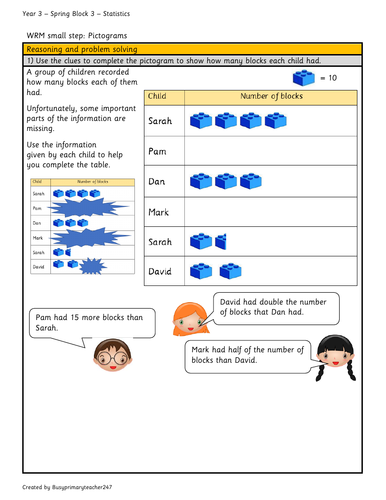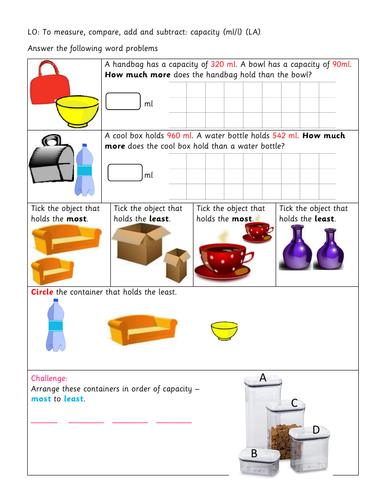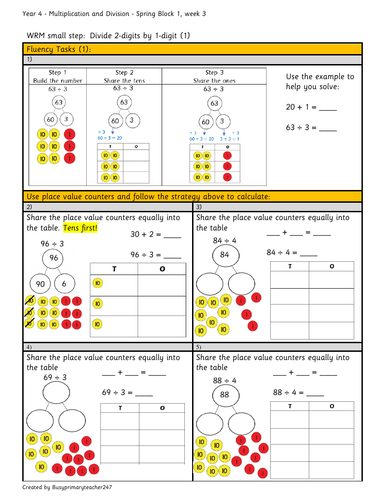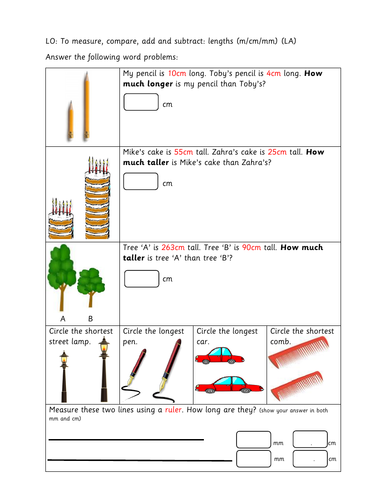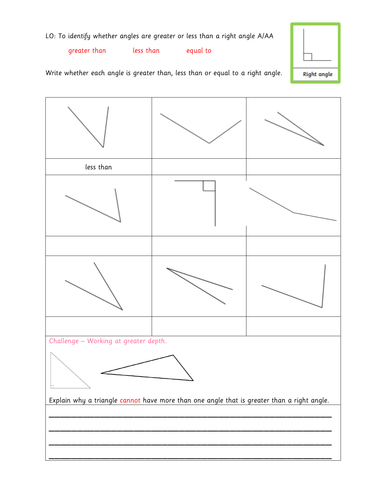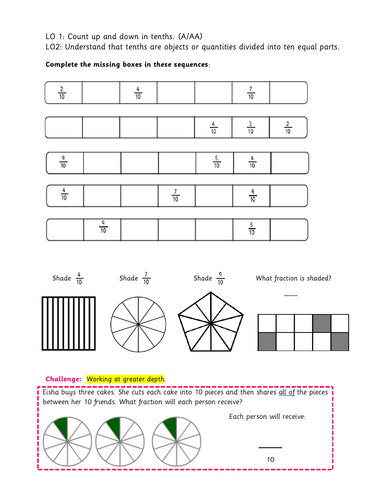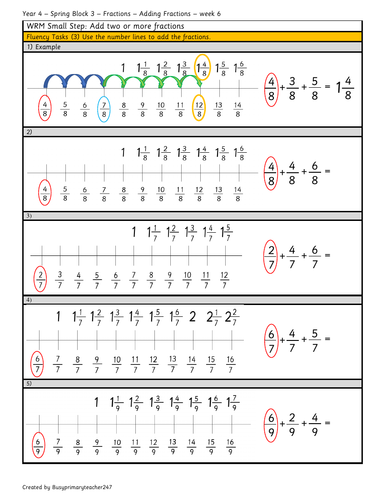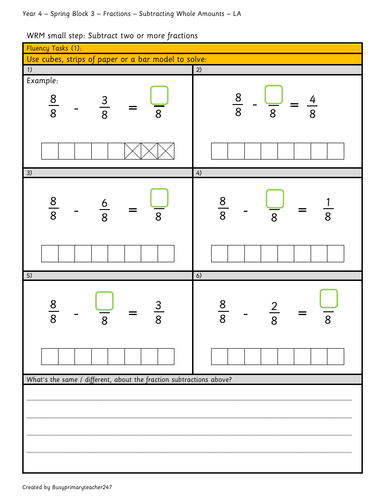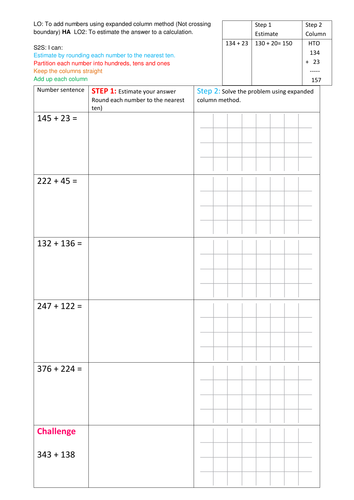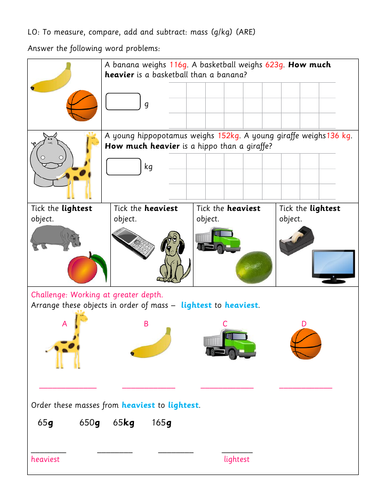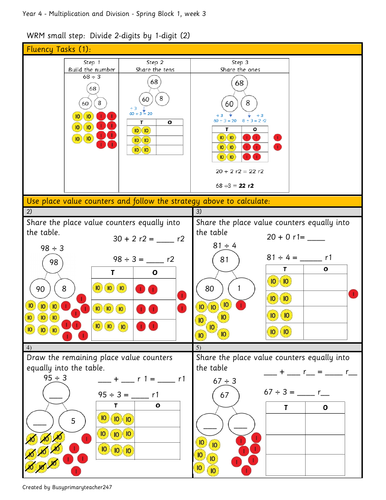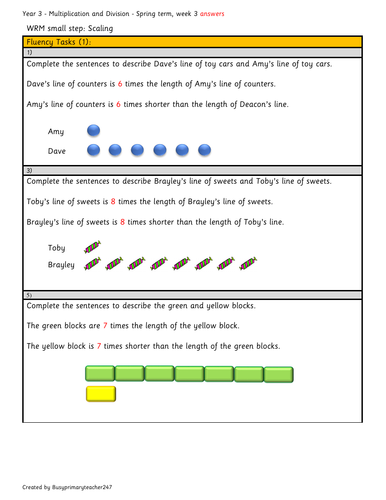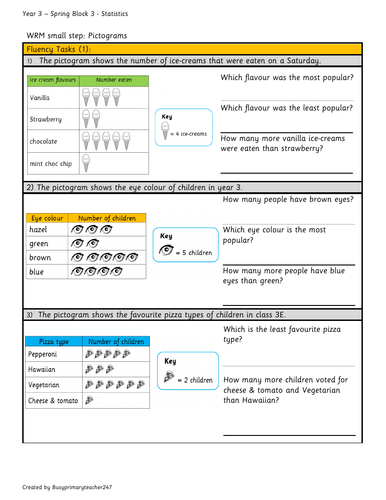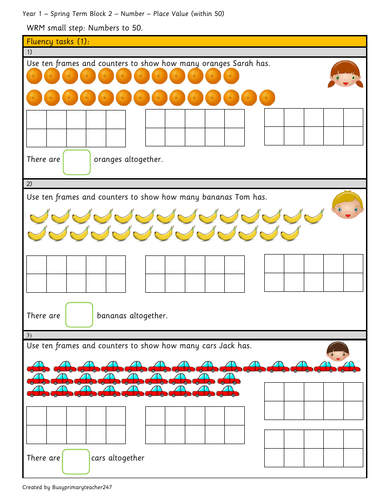120Uploads
182k+Views
67k+Downloads
All resources

Year 3 - interpreting pictograms (2)
This resources enables children to read and interpret information from pictograms, make comparisons and ask questions about data. It includes worksheets linked to WRM fluency tasks 1 & 2 and reasoning questions.
WRM Small Step: pictograms
Curriculum links:
-Interpret and present data using bar charts, pictograms and tables.
-Solve one-step and two-step questions [for example, ‘How many more?’ and ‘How many fewer?’ using information presented in scaled bar charts and pictograms and tables.
Enjoy!
Your feedback is always welcome x

Year 3 - differentiated worksheets - Capacity
Here are 2 differentiated worksheets based on the capacity of objects. It includes addition, subtraction, multiplication (integer scaling) and reasoning questions.
Curriculum links:
-Measure, compare, add and subtract: Capacity (ml/l)
-Compare the capacity of objects using mixed units (ml/l)
-Compare the capacity of objects using simple scaling by integers.
I hope you find this resource useful.
Your feedback is always welcome x

Year 4 - Divide 2-digits by 1-digit numbers
This resource links to Year 4, Spring, block 1(week 3) Multiplication, and Division and small step 'Divide 2-digits by 1-digit numbers'
The contents include differentiated worksheets (and answers) that follow the concrete, pictorial and abstract method for maths mastery. They also include reasoning and problem-solving.
Curriculum links:
- Recall and use multiplication and division facts for multiplication tables up to 12 ×12.
- Use place value, known and derived facts to multiply and divide mentally, including multiplying by 0 and 1; dividing by 1; multiplying together three numbers.
- Recognise and use factor pairs and commutativity in mental calculations.
-Solve problems involving multiplying and adding, including using the distributive law to multiply two digit numbers by one digit, integer scaling
problems and harder correspondence problems such as n objects are connected to m objects.
I hope you find these useful,
Your feedback is always welcome x

Place Value - Ordering Numbers Within 50
This resource links with Year 1, Spring Block 2, Number: Place Value (within 50) and uses a concrete - pictorial -abstract method to support the teaching of ordering numbers within 50. It also includes answers.
Curriculum Links
-Count to 50 forwards and backwards, beginning with 0 or 1, or from any number.
-Count, read and write numbers to 50 in numerals.
-Identify and represent numbers using objects and pictorial representations including the number line, and use the language
of: equal to, more than, less than (fewer), most, least.
I hope you find this resource useful x

Year 3 - differentiated worksheets - length
Here are 2 differentiated worksheets based on the length of objects. It includes addition, subtraction, multiplication (integer scaling) and reasoning questions.
Curriculum links:
-Measure, compare, add and subtract: length (mm/cm/m/km)
-Compare the length of objects using mixed units (mm/cm/m/km)
-Compare the length of objects using simple scaling by integers.
I hope you find this resource useful.
Your feedback is always welcome x

Year 1 - Spring block 1 - Addition and Subtraction - Related facts (week 4)
This 11-page resouce follows the concrete-pictorial-abstract approach to Maths Master and also includes answers.
Linked to small step 'Related facts' for week 4, Spring block 1.
Curriculum links:
-Represent and use number bonds and related subtraction facts within 20 -Read, write and interpret mathematical statements involving addition (+), subtraction (-) and equals (=) signs.
-Add and subtract one-digit and two-digit numbers to 20, including zero. -
Solve one-step problems that involve addition and subtraction, using concrete objects and pictorial representations, and missing number problems such as 7= ꙱–9
I hope you find this resource useful,
Your feedback is always welcome :)

Year 1 Counting in 5s
This resource contains varied fluency worksheets that allow children to practise the skill of counting in 5s using concrete, pictorial and abstract methods. Also included, are reasoning and problem-solving questions, and answer sheets.
WRM links: Year 1 Spring Block 2, Number, Place Value, Numbers within 50 (week 7)
Small Step: Count in 5s
Curriculum Links
• Count to 50 forwards and backwards, beginning with 0 or 1, or from any number.
• Count, read and write numbers to 50 in numerals.
• Given a number, identify one more or one less.
• Identify and represent numbers using objects and pictorial representations including the number line, and use the language of: equal to, more than, less than (fewer), most, least.
• Count in multiples of twos, fives and tens.
I hope you find this resource useful.
Enjoy x

Year 4 - Subtracting fractions
This resource uses a concrete – pictorial – abstract approach to help children gain fluency and mastery.
Curriculum links:
Solve problems involving increasingly harder fractions to calculate quantities, and fractions to divide quantities, including non-unit fractions where the answer is a whole number.
Add and subtract fractions with the same denominator.
Your feedback is always welcome x

Year 3 - Greater than less than a right angle differentiated assessment
Worksheet / assessment focusing on angles being greater than or less than a right angle. Differentiated into BA and A/AA (Includes greater depth question)
Links to Rising Stars Objectives: Identify angles greater than or less than a right angle.

Year 3 - counting up and down in tenths
Differentiated worksheets based on the National Curriculum and Rising Stars objectives:
- Count up and down in tenths.
- Understand that tenths are objects or quantities divided into ten equal parts.
Includes greater depth question.

Year 4 Count in fractions
This resource links to the WRM Spring block 3 Fractions unit and focuses on adding fractions with the same denominator. As requested, I have included more fluency and reasoning questions.
National curriculum links:
Solve problems involving increasingly harder fractions to calculate quantities, and fractions to divide quantities, including non-unit fractions where the answer is a whole number.
Add and subtract fractions with the same denominator.
Enjoy x

Year 4 - Subtracting from whole amounts (fractions)
This resource supports WRM Year 4 Spring block 3, Number – Fractions. Small Step: Subtracting from whole amounts. It also links to Fluency task 1.
It uses a concrete – pictorial – abstract approach to help children gain fluency and mastery. It is differentiated 2 ways and includes answers.
Curriculum links:
Solve problems involving increasingly harder fractions to calculate quantities, and fractions to divide quantities, including non-unit fractions where the answer is a whole number.
Add and subtract fractions with the same denominator.
Your feedback is always welcome x

Year 3 - 3-digit by 2-digit column addition with estimating and rounding (No exchanging)
Year 3
3-digit by 2-digit column addition with estimating and rounding (No exchanging) Differentiated worksheets BA, MA, HA
Enjoy! Your feedback is always welcome x

Year 3 - Spring week 1 - Multiplication and Division
This set of resources follows the concrete-pictorial-abstract method of Maths Mastery. It contains fluency, reasoning and problem-solving tasks.
The worksheets are differentiated between lower ability and age-related and the answers are included :)
Links directly to WRM small steps:
- Comparing statements
- Related calculations
- Multiply 2-digits by 1-digit (1)
National curriculum links:
-Recall and use multiplication and division facts for the 3, 4 and 8 multiplication tables.
-Write and calculate mathematical statements for multiplication and division using the multiplication tables they know, including for two-digit numbers times one-digit numbers, using mental and progressing to formal written methods.
-Solve problems, including missing number problems, involving multiplication and division, including positive integer scaling problems and correspondence problems in which n objects are connected to m objectives.
I hope you find these resources helpful!
Your feedback is always welcome x

Year 3 - differentiated worksheets - Mass
Here are 2 differentiated worksheets based on the weight of objects. It includes addition, subtraction, multiplication (integer scaling) and reasoning questions.
Curriculum links:
-Measure, compare, add and subtract: mass (g/kg)
-Compare the mass of objects using mixed units (g/kg)
-Compare the weight of objects using simple scaling by integers.
I hope you find this resource useful.
Your feedback is always welcome x

Year 4 - Spring block 1 - Divide 2-digits by 1-digit (2) week 3
This resource links to Year 4, Spring, block 1(week 3) small step 'Divide 2-digits by 1-digit (2)'
The contents include differentiated worksheets (and answers) that follow the concrete, pictorial and abstract method for maths mastery. They also include reasoning and problem-solving.
Curriculum links:
- Recall and use multiplication and division facts for multiplication tables up to 12 ×12.
- Use place value, known and derived facts to multiply and divide mentally, including multiplying by 0 and 1; dividing by 1; multiplying together three numbers.
- Recognise and use factor pairs and commutativity in mental calculations.
-Solve problems involving multiplying and adding, including using the distributive law to multiply two digit numbers by one digit, integer scaling
problems and harder correspondence problems such as n objects are connected to m objects.
I hope you find these useful,
Your feedback is always welcome x

Year 3 - Spring block 1 - Scaling (week 3)
This set of resources follows the concrete-pictorial-abstract method of WRM and Maths Mastery. It contains fluency, reasoning, and problem-solving tasks linked to WRM small step - Scaling (week 3)
The worksheets are differentiated between lower ability and age-related and the answers are included :)
UK National curriculum links:
-Recall and use multiplication and division facts for the 3, 4 and 8 multiplication tables.
-Write and calculate mathematical statements for multiplication and division using the multiplication tables they know, including for two-digit numbers times one-digit numbers, using mental and progressing to formal written methods.
-Solve problems, including missing number problems, involving multiplication and division, including positive integer scaling problems and correspondence problems in which n objects are connected to m objectives.
Australian Curriculum (V8.3)
-Apply place value to partition, rearrange and regroup numbers to at least 10 000 to assist calculations and solve problems (ACMNA053)
-Recall multiplication facts of two, three, five and ten and related division facts (ACMNA056)
-Represent and solve problems involving multiplication using efficient mental and written strategies and appropriate digital technologies (ACMNA057)
-fluency includes recalling multiplication facts, using familiar metric units to order and compare objects, identifying and describing outcomes of chance experiments, interpreting maps and communicating positions.
-problem-solving includes formulating and modelling authentic situations involving planning methods of data collection and representation, making models of three-dimensional objects and using number properties to continue number patterns
- reasoning includes using generalising from number properties and results of calculations, comparing angles and creating and interpreting variations in the results of data collections and data displays.
I hope you find these resources helpful!
Your feedback is always welcome x

Year 3 - Question strips linked to WRM Spring block 1 - weeks 1-3
A handy set of resources that can be used as a warm-up task, extension tasks, formative and summative assessment. They also compliment the other packs of works sheets that are available in my shop.
They link directly to WRM Small steps:
Comparing statements
Related calculations
Multiply 2-digits by 1-digit (1)
Multiply 2-digits by 1-digit (2)
Divide 2-digits by 1-digit (1)
Divide 2-digits by 1-digit (2)
Divide 2-digits by 1-digit (3)
Scaling
How many ways?
Curriculum links:
-Recall and use multiplication and division facts for the 3, 4 and 8 multiplication tables.
-Write and calculate mathematical statements for multiplication and division using the multiplication tables they know, including for two-digit
numbers times one-digit numbers, using mental and progressing to formal written methods.
-Solve problems, including missing number problems, involving multiplication and division, including positive integer scaling problems and correspondence problems in which n objects are connected to m objects.
I hope you find these useful,
Your feedback is always welcome x

Year 3 - interpreting pictograms (1)
This resources enables children to read and interpret information from pictograms, make comparisons and ask questions about data.
WRM Small Step: pictograms
Curriculum links:
-Interpret and present data using bar charts, pictograms and tables.
-Solve one-step and two-step questions [for example, ‘How many more?’ and ‘How many fewer?’ using information presented in scaled bar charts and pictograms and tables.
Enjoy!
Your feedback is always welcome x
Edited
Error on Q4 has been corrected.

Year 1 – Spring Block 2 – Number Place Value (Within 50) - week 5- numbers to 50
This resource follows the concrete-pictorial-abstract approach to Maths Mastery and also includes reasoning questions. It is linked to WRM small steps: Numbers to 50.
Curriculum links:
- Count to 50 forwards and backwards, beginning with 0 or 1, or from any number.
- Count, read and write numbers to 50 in numerals.
- Identify and represent numbers using objects and pictorial representations including the number line, and use the language of: equal to, more than, less than (fewer), most, least.
I hope you find this resource useful,
Your feedback is always welcome :)

